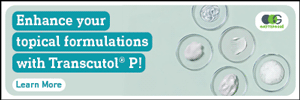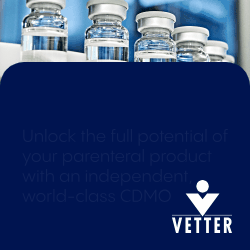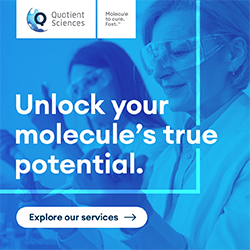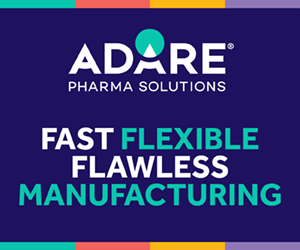Drug Delivery
Vectura & Inspira Pharmaceuticals Sign Agreement to Develop Potential Inhaled Treatment for COVID-19
Vectura Group plc and Inspira Pharmaceuticals Limited recently announced an agreement to develop an inhaled formulation of Inspira’s lead drug candidate for the potential treatment of….
Gerresheimer Presents Innovative SensAIR Platform for First Drug Delivery Device for Biologics
With SensAIR, Gerresheimer presents for the first time a new platform for on-body infusion pumps that can deliver drugs of higher viscosity, such as monoclonal antibodies (mAbs), with precise dosing and safety….
The FDA Expands Collaboration With CN Bio to Investigate Lung-on-a-Chip Model for Inhaled Drug Evaluation Applications
CN Bio recently announced the US FDA has extended its research collaboration for an additional 3 years. The scope of the research carried out with…
SPECIAL FEATURE - PFS & Parenteral Manufacturing: How COVID-19 Changed the Market
Contributor Cindy Dubin explores how device developers and parenteral contract development and manufacturing organizations (CDMOs) are addressing current challenges, as well as advancements in customized device design, the continuous effort to incorporate safety and human factors, and how COVID-19 is shaping the future of the market.
FORMULATION FORUM - Considerations in Formulation Development of Injectable Solutions
Jim Huang, PhD, reviews how injectable solutions offer an attractive alternative to oral dosage form due to fast onset, reproducible PK/efficacy profile, high bioavailability as a result of bypassing the oral absorption barrier, and suitability of administration under hospital setting.
GLOBAL REPORT - 2020 Global Drug Delivery & Formulation Report: Part 3, Notable Drug Delivery & Formulation Transactions & Technologies of 2020
In part 3 of this 4-part series, PharmaCircle, in collaboration with Drug Development & Delivery, focuses on several notable drug delivery and formulation transactions and technologies.
DRY-POWDER THERAPEUTICS - Respiration Inspiration: Local Treatment of Lung Cancer by Dry-Powder Inhaler
Philip Kuehl, PhD, and Kimberly B. Shepard, PhD, describe the formulation and manufacturing considerations for development of dry-powder therapeutics for local treatment of lung cancer. Two case studies are presented in which two approved drugs are successfully formulated for DPI administration to the lung.
EXECUTIVE INTERVIEW - Micropore: Innovation in Drug Delivery
Dai Hayward, CEO at Micropore, discusses his company’s expertise and underpinning technology in the development of safe, efficient, and scalable continuous manufacturing of drug delivery solutions.
EXECUTIVE INTERVIEW - Lexaria Bioscience Corp.: Stretching Its Legs
John Docherty, President of Lexaria, discusses how the company’s recent uplist to the NASDAQ has resulted in its largest capital injection to date, which will allow it to focus on preclinical and clinical testing programs for DehydraTECH formulations across three main areas of interest.
INJECTABLES MANUFACTURING - Manufacturing Injectable Devices: Why Modern Means Modular
Raffaele Pace, MMe, MBA, reviews how today’s drug delivery devices must be more mobile, less intrusive, and simpler than ever before – all while remaining cost competitive.
Daré Bioscience Announces the Presentation of DARE-BVFREE Phase 3 Clinical Trial Results
Daré Bioscience, Inc. recently announced that data from the DARE-BVFREE Phase 3 study of DARE-BV1, a thermosetting vaginal gel for the treatment of bacterial vaginosis, was….
Brickell Biotech Completes Patient Enrollment in US Phase 3 Pivotal Cardigan I Study
Brickell Biotech, Inc. recently announced completion of patient enrollment in the Phase 3 pivotal Cardigan I study and that the Cardigan II study has surpassed…
CordenPharma Colorado Expands Lipid Excipients Purfication
In response to the COVID-19 pandemic, mRNA (messenger RNA) vaccines have catapulted to center stage of the pharmaceutical and biotechnology industry. As of early 2021,…
CeQur Raises $115 Million to Support Commercialization & Scale-Up of Automated Manufacturing for CeQur Simplicity Wearable Insulin Delivery Device
CeQur recently announced the close of an oversubscribed $115-million equity financing. The company will use the funds to advance commercial plans for CeQur Simplicity, including…
Where Do We Stand on Poorly Soluble Drugs and Peptides in Oral Delivery?
The Rule of 5 suggests that, for oral bioavailability, a better chance for oral absorption is obtained when the molecules are within the parameters of the Rule of 5’. However, the pharmaceutical industry is achieving oral efficacy with drugs that exceed….
Bespak by Recipharm Webinar: Learn How To Overcome Viscous Formulation Challenges For Parenteral Delivery
There have been many challenges holding back widespread adoption of self-administered injectable formulations. One of the most pressing is the need to develop an auto-injector with a fine enough needle for….
AEON Biopharma Doses First Patient in Phase 2 Trial of ABP-450 for the Treatment of Cervical Dystonia
AEON Biopharma, Inc. recently announced the initiation of patient dosing in a Phase 2 study of ABP-450 for the treatment of cervical dystonia. The company…
AIM ImmunoTech Posts New Developments in Intranasal COVID-19 Treatment Clinical Study
AIM ImmunoTech Inc. recently announced it has completed dosing of Cohort 1 in a Phase 1 clinical study on the safety of AIM’s drug Ampligen…
Progenity & Ionis Pharmaceuticals Enter Agreement to Evaluate Progenity’s Ingestible Oral Biotherapeutics Technology for Delivery of Antisense Therapies
Progenity, Inc. recently announced an agreement with Ionis Pharmaceuticals to evaluate the safety, tolerability, and performance of Progenity’s Oral Biotherapeutics Delivery System (OBDS) for oral systemic delivery of….
Moderna & Catalent Announce Long-Term Strategic Collaboration for Dedicated Vial Filling of Moderna’s COVID-19 Vaccine & Clinical Portfolio
Moderna, Inc. and Catalent, Inc. recently announced the expansion of their strategic collaboration to dedicate a new high-speed vial filling line for the manufacture of the Moderna COVID-19 Vaccine and potentially other….
What are Drug Delivery Systems?
Drug delivery systems are engineered technologies for the targeted delivery and/or controlled release of therapeutic agents. The practice of drug delivery has changed significantly in the past few decades and even greater changes are anticipated in the near future. Drug delivery includes but is not limited to oral delivery, gene/cell delivery, topical/transdermal delivery, inhalation deliver, parenteral delivery, respiratory delivery, capsules, particle design technology, buccal delivery, etc.
The Evolution of Drug Delivery Systems
Drug delivery systems have greatly evolved over the past 6 decades. In the past 12 years specifically, there have been huge advancements in drug delivery technology. For instance, advanced medication delivery systems, such as transdermal patches, are able to deliver a drug more selectively to a specific site, which frequently leads to easier, more accurate, and less dosing overall. Devices such as these can also lead to a drug absorption that is more consistent with the site and mechanism of action. There are other drug delivery systems used in both medical and homecare settings that were developed because of various patient needs and researchers continue to develop new methods.
Drug Delivery System Market Size
The pharmaceutical drug delivery market size is studied on the basis of route of administration, application, and region to provide a detailed assessment of the market. On the basis of route of administration, it is segmented into oral delivery, pulmonary delivery, injectable delivery, nasal delivery, ocular delivery, topical delivery, and others.
The estimated global market size of drug delivery products was $1.4 trillion in 2020. Unfortunately, 40% of marketed drugs and 90% of pipeline drugs (mostly small molecules) are poorly soluble in water, which makes parenteral, topical, and oral delivery difficult or impossible. In relation, poor solubility often leads to low drug efficacy. Add in the fact that many other hurdles exist in the form of drug loading, stability, controlled release, toxicity, and absorption – it’s not hard to understand the difficulties in bringing new drug products to market. Additionally, biopharmaceuticals (proteins, peptides, nucleic acids, etc) and combination drug products possess many of these same problematic obstacles that affect efficacy. These challenges, coupled with the complexity and diversity of new pharmaceuticals, have fueled the development of a novel drug delivery platforms that overcome a great many bioavailability and delivery obstacles. By leveraging these platforms, pharmaceutical and biopharmaceutical companies can improve dosing accuracy, efficacy, and reproducibility in their drug discovery and drug delivery research.
Drug Delivery System Demand
The demand for pharmaceutical products worldwide is only going to increase in the coming years, as old and emerging diseases continue to threaten the well-being of people globally. Drug discovery efforts are expected to intensify, generating a large variety of active compounds with vastly different structures and properties. However, it is well known that despite tremendous output of the drug discovery process, the success rate of a candidate compound becoming an approved drug product is extremely low. The majority of candidate compounds are discarded due to various hurdles in formulation and preclinical testing (such as issues with solubility, stability, manufacturing, storage, and bioavailability) before even entering into clinical studies. Therefore, advances in formulation and drug delivery, especially the development of new and versatile biomaterial platforms as effective excipients, may salvage many “difficult,” otherwise triaged, drug compounds, and significantly enhance their chance of becoming viable products. Furthermore, breakthroughs in biomaterial platform technologies will also facilitate life cycle management of existing APIs through reformulation, repurposing of existing APIs for new indications, and development of combination products consisting of multiple APIs.














